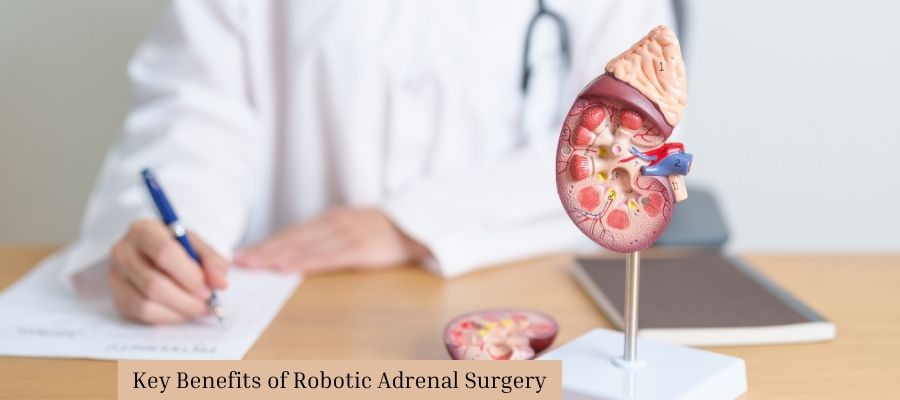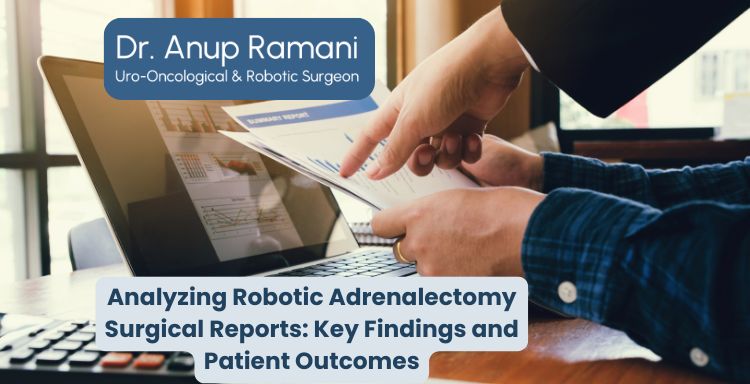Dr Anup Ramani @ Copyright 2024
By Dr. Anup Ramani
Robotic adrenalectomy has emerged as a leading solution in the treatment of adrenal gland disorders. As a Minimal invasive surgical technique, it allows for greater precision, reduced recovery time and fewer complications compared to traditional open surgery. The adrenal glands play a crucial role in hormone production and when they develop tumors or dysfunction, the resulting health problems can be significant. In this article, we will analyze robotic adrenalectomy surgical reports, focusing on key findings and patient outcomes that highlight its effectiveness in treating adrenal gland conditions.
Adrenal gland surgeries, particularly those involving robotic systems, are gaining traction in medical practices across the globe. Surgeons specializing in adrenal gland treatment increasingly favor robotic approaches because of their ability to enhance surgical outcomes while minimizing patient trauma. This article presents an in-depth analysis of surgical reports and the outcomes observed in patients undergoing robotic adrenalectomy, focusing on the implications for adrenal gland surgery.
What is Robotic Adrenalectomy and How Does It Work?
Robotic adrenalectomy is a type of Minimal invasive surgery used to remove one or both of the adrenal glands. These glands are essential for producing various hormones, including adrenaline, cortisol and aldosterone, which help regulate vital functions in the body. Tumors or other conditions affecting the adrenal glands may require surgical intervention.
In robotic adrenalectomy, a surgeon uses a robotic system to perform the surgery with highly precise instruments controlled remotely. The robotic platform offers better visualization of the adrenal glands, using more flexibility in movement, allowing surgeons to navigate complex anatomical structures with greater ease.

The Benefits of Robotic Systems in Adrenal Gland Surgery
The primary advantages of robotic adrenalectomy include:
- Reduced recovery time: Quicker post-operative recovery and reduced hospital stays.
- Greater precision: Enhanced ability to remove the tumor while preserving surrounding structures.
- Lower risk of complications: Less blood loss, fewer infections and reduced scarring.
Robotic systems offer a significant improvement over conventional techniques, making them a valuable tool for surgeons around the world.
How Have Surgical Reports Advanced the Understanding of Robotic Adrenalectomy?
Surgeons and medical professionals closely examine surgical reports and patient outcomes to refine treatment strategies and ensure the best results for patients. By analyzing large-scale data from multiple hospitals and adrenal gland treatment, key findings have emerged that showcase the benefits and challenges of robotic adrenalectomy.
Key Findings from Surgical Reports
Lower Complication Rates
Surgical reports consistently highlight the reduced incidence of complications in robotic adrenalectomy procedures. In particular, these procedures are associated with lower rates of bleeding, infection and damage to surrounding organs. The robotic systems’ precision allows surgeons to perform delicate procedures with fewer risks.
Shorter Hospital Stays and Faster Recovery
Patients who undergo robotic adrenalectomy typically experience shorter hospital stays compared to those who undergo traditional open surgery. The Minimal invasive nature of the procedure leads to quicker recovery times, with many patients resuming normal activities within a few weeks post-surgery.
Higher Patient Satisfaction
Surgical reports reveal that patients undergoing robotic adrenalectomy often report higher levels of satisfaction compared to those who have traditional open surgeries. Reduced pain, fewer complications and a faster return to normal life contribute to an overall improved patient experience.
Comparable Cancer Control in Malignant Cases
In cases where adrenal tumors are malignant, robotic adrenalectomy has shown comparable cancer control rates to traditional open surgeries. The enhanced visualization and precision allow surgeons to remove tumors while minimizing the risk of leaving behind malignant tissue.
Long-Term Outcomes and Recurrence Rates
Long-term studies examining recurrence rates in patients who have undergone robotic adrenalectomy show promising results. In patients with benign adrenal tumors, recurrence is rare, while patients with cancerous growths are monitored closely for any signs of reoccurrence, with regular follow-up imaging and testing.
What Our Patients Are Saying
What are the Key Patient Outcomes of Robotic Adrenalectomy?
The success of robotic adrenalectomy is reflected in its patient outcomes, with many patients reporting significant improvements in both their quality of life and health following the procedure.
Improved Hormonal Balance
One of the primary benefits of adrenal gland surgery is restoring hormonal balance in patients whose adrenal glands are producing excess hormones. Robotic adrenalectomy allows for the precise removal of affected glands, which helps patients regain hormonal stability and experience relief from symptoms.
Minimal Pain and Faster Recovery
Since robotic adrenalectomy uses small incisions, patients experience significantly less pain than those undergoing traditional open surgery. Pain management is generally more straightforward and the overall recovery period is reduced, allowing patients to return to their regular activities faster.
Long-Term Health Monitoring and Support
While robotic adrenalectomy provides significant improvements in the patient’s health, long-term monitoring is essential, especially in patients with malignant tumors. Patients often require follow-up care and regular check-ups to ensure no recurrence of cancer and that their hormonal levels are stable.
How Do Robotic Adrenalectomy Surgical Reports Compare Across Different Centers?
When analyzing surgical reports from different medical centers, it’s important to consider various factors that influence patient outcomes, such as the experience of the surgeon, the quality of the medical equipment and the overall healthcare infrastructure of the treatment center.
Key Observations from Comparative Reports
- Surgeon Experience
The experience and skill of the robotic adrenalectomy surgeon can play a significant role in the outcome of the procedure. Reports show that centers with surgeons who have performed a higher volume of robotic surgeries tend to have better outcomes, including fewer complications and shorter recovery times.
- Technological Advancements
Advances in robotic systems and tools have a direct impact on patient outcomes. Centers that utilize the latest technologies, such as high-definition 3D cameras and robotic arms with enhanced maneuverability, report better surgical precision and faster recovery times.
- Post-Operative Care
The quality of post-operative care also influences patient outcomes. Surgical reports from centers with robust follow-up care, including regular monitoring and hormonal testing, show lower recurrence rates and higher patient satisfaction.
Conclusion
Robotic adrenalectomy represents a significant advancement in the treatment of adrenal gland disorders. Through the use of advanced robotic systems, surgeons can achieve greater precision, faster recovery times and improved patient outcomes. Surgical reports highlight the benefits of this technique, including reduced complication rates, shorter hospital stays and higher patient satisfaction.
As the medical field continues to evolve, robotic surgery is set to play an even more prominent role in treating adrenal gland disorders. With specialized surgeons and top-tier treatment, robotic adrenalectomy has become an increasingly accessible and reliable option for patients in need of adrenal gland surgery.
FAQs About Robotic Adrenalectomy
What is robotic adrenalectomy?
Robotic adrenalectomy is a Minimal invasive surgical procedure used to remove one or both of the adrenal glands. It involves using robotic technology to enhance the surgeon’s precision, resulting in smaller incisions, reduced recovery times and improved patient outcomes.
What are the benefits of robotic adrenalectomy over traditional surgery?
Robotic adrenalectomy offers several advantages over traditional surgery, including smaller incisions, less blood loss, fewer complications, shorter hospital stays, faster recovery times and improved precision.
Is robotic adrenalectomy suitable for all patients?
Robotic adrenalectomy is typically recommended for patients with localized adrenal disorders or tumors that can be safely removed using a Minimal invasive approach. Surgeons will assess each patient’s individual case to determine if robotic surgery is appropriate.
About Author

Uro-Oncological & Robotic Surgeon
Dr. Anup Ramani is a robotic uro-oncological surgeon and an internationally recognized expert in robotic surgery for prostate, kidney and urinary bladder cancers. With more than two decades of robotic experience and 2,000+ robotic procedures, he brings unmatched precision and outcomes to complex uro-oncology cases. He is widely published in his field and is known for a personal, transparent approach-often spending over an hour in initial consultations to educate patients on its disease, surgery and recovery. His expertise spans prostate cancer treatment, kidney and bladder cancer surgery, adrenal gland surgery, kidney stone treatment, penile cancer surgery and enlarged prostate management. Dr. Ramani advocates the advantages of robotic surgery-magnified 3D vision, tremor-filtered precision, minimal scarring, lower blood loss and faster recovery-helping patients return to life sooner.
Table of Contents
Recent Blogs
Best Uro-Oncological surgeon
Specialist in India for Robotic Surgery
MCh, DNB, MS, DNB
Dr. Anup Ramani
CONTACT
Uro-Oncologist in India,
Best Robotic Surgeon for Uro Oncology Surgery
1407, One Lodha Place Next to World Towers Senapati Bapat Marg, Worli, Mumbai. 400013.
Dr Anup Ramani @ Copyright 2024 – Website Maintenance, SEO & GEO by Opal Infotech
- Partial penectomy is done in cases where glans and distal penis is involved with carcinoma.
- Partial penectomy is a type of organ-preserving surgery. Preservation of sexual and micturational function depends on the surgical dissection and reconstruction of residual urethra.
- Patients who develop stones in the kidney or ureter, often experience severe pain.
- This condition usually needs a procedure to remove the kidney stones.
- This procedure is called ureteroscopy and is performed very commonly.
- It does not require any cuts and hence it is painless.
- The procedure is performed with an endoscope inserted through the penis under spinal anesthesia.
- The scope is inserted through the penis into the kidney and stones are dissolved with a laser.
- The procedure takes about 40-50 minutes.
- A catheter (urine pipe) is kept after the procedure to drain the bladder. A stent is kept in the kidney at the same time.
- Patient is mobile and walking in the room the same evening.
- Hospital stay is one night and patient is discharged the next day after removal of the catheter.
- Patient has to come back after six weeks to remove the stent in the kidney.
- Patients can resume office a week after surgery and heavy activities like running, weight lifting, a month after the procedure.
- We offer fixed packages for this procedure which can be obtained by calling our helpline +91 9967666060.
- Men with an enlarged prostate, which is a normal ageing changes, often experiencing difficulty passing urine. This condition usually needs a procedure to trim the prostate and relieve the blockage.
- This procedure is called TURP and is performed very commonly.
- It does not require any cuts and hence it is painless.
- The procedure is performed with an endoscope inserted through the penis under spinal anaesthesia.
- The overgrown prostate is dissolved with a laser bloodlessly.
- The procedure takes about 40 minutes.
- A catheter (urine pipe) is kept after the procedure to drain the bladder.
- Patient is mobile and walking in the room the same evening.
- Hospital stay is two nights and patient is discharged with the catheter, which is removed after 4 days.
- Patients can resume office a week after surgery and heavy activities like running, weight lifting, a month after the procedure.
- We offer fixed packages for this procedure which can be obtained by calling our helpline +91 9967666060.
-
Robotic adrenalectomy is a sophisticated, complex surgery and it is very important that an experienced surgeon performs this surgery to avoid major complications.
-
Once the anesthesia is done, and patient positioned, three micro cuts (3mm each) are made in the patient’s abdomen.
-
The arms of the Da Vinci robot are connected to the cuts via ports (tubes).
-
Dr. Ramani then sits in the controlling console to perform the surgery.
-
On an average, a robotic adrenalectomy takes one hour.
-
The surgery is almost completely bloodless and there has never been any need to transfuse blood after surgery.
-
A urine catheter and bag to drain the bladder is inserted during surgery.
-
A tiny drain pipe may be inserted in the surgical side of the abdomen, connected to a bag.
-
Patient is kept nil-by-mouth the day of the surgery, with IV fluids. Sips of water are started the next day and solid food by day three.
-
The drain pipe, if kept, is removed in the room on day 2 after surgery.
-
The catheter is removed on day two after surgery.
-
Total hospital stay for robotic adrenalectomy is 4 nights (including night before surgery).
-
Post discharge, a doctor from the surgical team visits the patient at home/ hotel room once every day.
On the day of discharge, patient is totally self-sufficient. They are able to walk freely without any pain, dress themselves, shower, toilet and they do not need to hire any nurse or help at home. Almost all patients are back to work within 2 weeks of surgery.
Heavy activities like running, weight lifting can be resumed after a month
Follow up after an adrenalectomy is in the form of CT scans, once a year for 5 years.
Local patients usually meet Dr. Ramani after two weeks to discuss report.Outstation patients are counselled on a phone consultation.
- Dr. Ramani is one of the very few surgeons in India who has the expertise to perform a robotic surgery for bladder cancer, which includes removing the urinary bladder and reconstructing a new bladder robotically.
- Robotic radical cystectomy is an extremely sophisticated, complex surgery and it is very important that an experienced surgeon performs this surgery to avoid major complications.
- Once the anaesthesia is done, and patient positioned, six micro cuts (3mm each) are made in the patient’s abdomen.
- The arms of the Da Vinci robot are connected to the cuts via ports (tubes).
- Dr. Ramani then sits in the controlling console to perform the surgery.
- On an average, a robotic radical cystectomy with an ileal conduit takes 3-4 hours.
- The surgery is almost completely bloodless and there has never been any need to transfuse blood after surgery.
- A urine catheter and bag to drain the new bladder is inserted during surgery.
- Two tiny drain pipe in inserted in the surgical side of the abdomen, connected to a bag.
- Patient is kept nil-by-mouth for 4 days after surgery with IV supplementation of patient’s daily requirements of calories, fats, carbohydrates, proteins and electrolytes.
- The drain pipes are removed in the room on day 3-5 after surgery.
- Total hospital stay for radical cystectomy is 8 nights (including night before surgery).
- Post discharge, a doctor from the surgical team visits the patient at home/ hotel room once every day.
- On the day of discharge, patient is totally self-sufficient. They are able to walk freely without any pain, dress themselves, shower, toilet and they do not need to hire any nurse or help at home.
- Almost all patients are back to work within 6 weeks of surgery. Heavy activities like running, weight lifting can be resumed after two months.
Follow up after a radical a cystectomy is in the form of CT scans, once a year for 5 years.
Histopathology report: Local patients usually meet Dr. Ramani after two weeks to discuss report.
Outstation patients are counselled on a phone consult. Depending on the report, patient may or may not need chemotherapy after surgery.
If chemo is needed, patients may choose to get it done with a medical oncologist of their choice or avail the services of one of the four medical oncologists on our team.
- Robotic partial nephrectomy is a sophisticated, complex surgery and it is very important that an experienced surgeon performs this surgery to avoid major complications. Robotic radical (total) nephrectomy is
- relatively easier but still requires significant experience to consistently deliver results.
- Once the anaesthesia is done, and patient positioned, five micro cuts (3mm each) are made in the patient’s abdomen.
- The arms of the Da Vinci robot are connected to the cuts via ports (tubes).
- Dr. Ramani then sits in the controlling console to perform the surgery.
- On an average, a robotic radical nephrectomy takes one hour and a robotic partial nephrectomy takes about an hour and half.
- The surgery is almost completely bloodless and there has never been any need to transfuse blood after surgery.
- A urine catheter and bag to drain the bladder is inserted during surgery.
- A tiny drain pipe in inserted in the surgical side of the abdomen, connected to a bag.
- Patient is kept nil-by-mouth the day of the surgery, with IV fluids. Sips of water are started the next day and solid food by day three.
- The drain pipe is removed in the room on day 3 after surgery. The catheter is removed on day two after surgery.
- Total hospital stay for radical/partial nephrectomy is 4 nights (including night before surgery).
- Post discharge, a doctor from the surgical team visits the patient at home/ hotel room once every day.
- On the day of discharge, patient is totally self- sufficient.
- They are able to walk freely without any pain, dress themselves, shower, toilet and they do not need to hire any nurse or help at home.
- Almost all patients are back to work within 2-3 weeks of surgery.
- Heavy activities like running, weight lifting can be resumed after a month.
- Follow up after a radical/partial Nephrectomy is in the form of CT scans, once a year for 5 years.
- Local patients usually meet Dr. Ramani after two weeks to discuss report.
- Outstation patients are counselled on a phone consultation.





